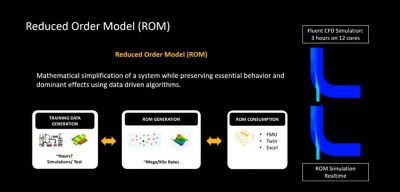
“Operating at the speed of relevance” is a United States national security maxim denoting the importance of responding to drivers of change in a flexible, agile, and intelligent manner.
This maxim has implications within the simulation sphere, as well, where simulation market leaders must respond quickly and flexibly when major technological developments — like advancements in graphics processing units (GPUs) and artificial intelligence (AI) — are changing the way simulations can be run.
Let's take a look at the next-generation technologies driving the computational fluid dynamics (CFD) industry, how Ansys is bringing these technologies into your software, and how you can leverage them to drive a positive change in your engineering workflows.
AI Is Enabling Rapid CFD Design Prediction
AI adoption in simulation has been steadily increasing, particularly in scenarios where creating and analyzing a vast quantity of data or design space is necessary. These scenarios can be seen in high-performance industries, such as automotive and aerospace, where extremely large models under tough environmental conditions need to be simulated to understand potential safety and reliability concerns. These models can generate vast amounts of data that need to be analyzed by an individual engineer or team and can be extremely time-intensive. Not to mention, there are times when running simulations can take longer than performing a physical test. This is not ideal, especially as a simulation can lose relevance if not turned around quickly.
AI is a good option to speed up data generation and data use in these large simulation model scenarios. AI can rapidly analyze vast quantities of data much faster than a single person, making AI tools for simulation a no-brainer to predict faster.
An introduction to the Ansys SimAI cloud-enabled artificial intelligence (AI) platform
The Ansys SimAI cloud-enabled AI platform enables you to leverage the accuracy of Ansys simulations with the predictive power of AI. This is a great timesaving and workflow efficiency tool that learns from your existing simulation data and generates optimized models quickly. The user experience (UX) also prioritizes simplicity for non-simulation experts, with no coding or data science expertise required. You simply upload your historical simulation data, select relevant performance metrics, and review the generated AI models to explore multiple design options and alternatives within minutes.
Our benchmark studies have shown that SimAI software can test design alternatives 10 to 100 times faster. This type of speed increase is a game-changer — not only for faster and more efficient workflows for engineers, but also for businesses where faster simulations can lead to faster design cycles and therefore an overall faster time to market.
"With Ansys SimAI, we will be able to easily test a design within minutes and rapidly analyze the results, ultimately redefining our digital engineering workflow and reshaping our perception of what is possible. By enhancing simulation speed, we can explore more technical possibilities during the upstream phase of our projects and reduce the overall time-to-market."

— William Becamel, Expert Leader in Numerical Modeling and Simulation, Renault Group
Source: Ansys Launches Ansys SimAI™ press release.
Leveraging AI is important for engineers and businesses to remain competitive and agile in a rapidly changing product development environment driven by tight deadlines and consumer demands.
Download our white paper to learn how you can assess new design performance in seconds.
ROMs and Data Fusion for Real-Time Simulation Throughout the Product Life Cycle
Reduced-order models (ROMs) are another AI-based tool that provides simplified representations of complex, high fidelity CFD models. ROMs are getting more popular as they are being used for different applications throughout product design life cycle.

Overview of a reduced-order model (ROM)
To create a ROM, engineers need to map model outputs to input excitations using training data generated through simulation or physical tests, or both. Once you have your training data, you can train your ROM so you end up with a lightweight model that runs in seconds with minimal storage requirements.
There are several scenarios throughout the product life cycle where ROMs can be used, including in bigger system models, digital twins, for transient or steady-state simulations, 1D-3D models, control software, and more. The real value is that ROMs will run in real-time, leveraging data-driven algorithms, while a CFD simulation with the same set of operating conditions can take significantly longer.
ROMs can also be enhanced and validated with data fusion, which ultimately reduces the need for extensive testing. Data fusion works by fusing two streams of data, typically a low-fidelity stream and a high-fidelity stream. When you combine the two, you end up with an accurate representation of your model while optimizing the time and cost.
ROMs can be used in early and late design cycles to improve product performance. ROMs are available in Ansys Fluent fluid simulation software with a CFD enterprise license.
Leveraging GPU Acceleration To Generate Data Quickly for AI and ROMs
AI and ROMs are both great tools to quickly understand and predict different design options, but they still require large amounts of data to work effectively. Generating data can take a significant amount of time, but we are seeing that time shorten through the recent advances in GPU-enabled CFD software.
For example, in the below DrivAer benchmark case, we saw a nearly 33x increase in solving speed when running Fluent software on eight NVIDIA A100 GPU cards compared against 80 Intel CPU cores. These GPU cards can be well worth the financial cost when they deliver exponential simulation speed increases.

When running a benchmark DrivAer model on different CPU and graphics processing unit (GPU) configurations, our results show that a single NVIDIA A100 GPU achieved more than five times greater performance and almost 33 times greater performance when scaling up to eight NVIDIA A100 GPUs.
Combining GPU-acceleration with AI is the future; and it’s the solution that engineers and businesses should be prioritizing. GPU-accelerated CFD studies will generate simulation results exponentially faster, typically within a single working day. Feeding these results into a tool like SimAI software or using it to build high-fidelity ROMs will quickly provide potential design optimization strategies that can be passed along to manufacturing teams. Combining these technologies into one cohesive solution means that workflows that used to last weeks or months, can now be potentially completed in a few working days.
The future of CFD simulation is being shaped, and the businesses and engineers who adopt the technology accelerating CFD simulations will bring new and superior innovations to market faster. The fusion of AI, GPUs, and ROMs are paving the way for an exciting future in CFD where complex, large scale, high-fidelity simulations will take hours or days to run instead of weeks or months. Ansys is committed to helping you adopt, implement and successfully use all of these technologies to improve your workflows and bottom line.
The Advantage Blog
The Ansys Advantage blog, featuring contributions from Ansys and other technology experts, keeps you updated on how Ansys simulation is powering innovation that drives human advancement.


